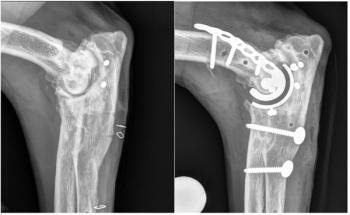
Natural toxins: Part 1 (Proceedings)
Species of poisonous snakes found in North Carolina - Pit Vipers (Copperhead (Agkistrodon contortrix), Cottonmouth (Agkistrodon piscivorous. Timber Rattlesnake (Crotalus horridus, Eastern diamondback rattlesnake (Crotalus adamanteus, Pygmy rattlesnake (Sistrurus miliarius), Elapidae Eastern coral snake (Micrurus fulvius fulvius).
Poisonous animals – Tissue is toxic; Poisoning through ingestion; Concentration differences in portions of the body – toxicity
Venomous animals – gland or glands which produces the venom and a Connecting system between gland and delivery apparatus.
Venom delivery is not "all or nothing", but rather is graded and their purposes are 1).
Capture and digestion of food, and 2). Offers protection against predators
Toxicity of venom and poison
The LD50 for any particular venom will vary, depending on:
- The type of animal it is tested in
- The route of injection
- The way the venom is prepared for injection
- Variability in both toxicity and composition of venom, both within a single animal, between animals of the same species
Properties of animal toxins
- Complex chemistry
- Proteins (Polypeptides, enzymes)
- Small molecules ( Serotonin, Lipids, amines)
- Carbohydrates
- Metals (Magnesium, calcium, and zinc are the most prevalent metals, copper has been detected in some venoms - lethality role??)
- Modified saliva
Venomous snakes
- Ectothermic reptiles
- There are at least 3,000 species of snakes (375 species danger to man; five (5) confirmed families
Pit Vipers (Crotalidae)
- Pit vipers (e.g., rattlesnakes, cottonmouth, moccasin, and copperhead).
- Viperine snakes have long, hinged, hollow fangs; they strike, inject venom (a voluntary action), and withdraw.
- Many bites by vipers reportedly do not result in injection of substantial quantities of venom
- Viperine venom is typicaly hemotoxic, necrotizing, and anticoagulant
- Neurotoxic components are present in the venom of some species. Mojave rattlesnake (Crotalus scutulatus).
Elapine Snakes (Cobra, mamba, and coral snakes)
- short fangs and tend to hang on and "chew" venom into their victims
- venom is neurotoxic and paralyzes the respiratory center
Snake Bite incidence
- Veterinary (Unknown; active humoral immunity can occur if multiple bites occur)
- Humans (Approximately 7500 reptile bites (2001) AAPCC report. Rattlesnakes are primarily implicated.
Poisonous snakes
Species of poisonous snakes found in North Carolina - Pit Vipers (Copperhead (Agkistrodon contortrix), Cottonmouth (Agkistrodon piscivorous. Timber Rattlesnake (Crotalus horridus, Eastern diamondback rattlesnake (Crotalus adamanteus, Pygmy rattlesnake (Sistrurus miliarius), Elapidae Eastern coral snake (Micrurus fulvius fulvius)
Rattlesnake venom
- Composition (Digestive enzymes, Spreading factors (hyaluronidases), Proteases, DNAses, RNAses)
Snake bites
Snakebite, with envenomation, is a true emergency ("Dry bites" account for ~ 50% of all bites). Rapid examination and appropriate treatment – essential. Keep the animal quiet and limit its activity
Crotalidae Snake Bite
Pain and edema around the bite site, Swelling, Dyspnea, Nausea, vomiting, or diarrhea
Coagulopathy (Thrombocytopenia), Weakness, Paresthesis, CNS depression – Neurologic; Hypotension/hypertension, Tachycardia, Muscle fasciculations.
Crotalidae Snake Bite – clinical signs
Late phase (> 24 hours); If the animal is active and alert after 24 hours, death due to the direct effects of the venom is unlikely; infection (possibly anaerobic) may be of concern
Crotalidae snake bite – diagnosis
Typical pit viper bites are characterized by severe local tissue damage that spreads from the bite site, tissue becomes markedly discolored within a few minutes, dark, bloody fluid may ooze from the fang wounds if not prevented by swelling, Skin sloughing, Fang mark (s) present.
Crotalidae snake bit "Treatment"
- Pit viper envenomation (Preventing or controlling shock - IV fluids to combat hypotension; neutralizing venom, Prevents/control disseminated intravascular coagulation (DIC), minimizing necrosis - Preventing secondary infection (Pseudomonous aeruginosa, Clostridium spp, Corynebacterium spp, Staphylocci spp; Corticosteroids - Prolong the clinical course but may help to control shock (controversial)
Antivenins - Polyvalent antivenin (horse-serum origin) – Wyeth "availability??
Polyvalent antivenin (sheep-serum origin) – IgG Fab's against four species
(Rattlesnakes (Eastern, Western, Mojave) Cottonmouth)
CroFab (Protherics)
Note Smaller animals receive a larger dose (per unit body weight) of venom than more larger animals and, accordingly, require proportionally larger doses of antivenin
- Must maintain patent airway, Tetanus antitoxin also should be administered
Other supportive treatment (e.g., blood transfusion in the case of hemolytic or anticoagulant venoms), Surgical excision is impractical or unwarranted, High-voltage, low amperage electric shock (not proven effective.
Avoid ice or cold application, tourniquets, or incisions to suck out the venom, all of which are outdated and may cause more injury
Eastern Coral Snake (Micrurus fulvius fulvius) - Red touch yellow bad for fellow. Red touch black good for Jack"
Coral snake
Bites are uncommon, account for less than 1% of venomous snakebites in the United States, intentional handling >> biting, most bites occur in the spring or fall, Small, fixed, hollow fangs in the anterior aspect of the mouth through which the snake conducts venom via a chewing motion, needs to hang on for a brief period to achieve significant envenomation, significant neurotoxicity, inducing neuromuscular dysfunction (limited enzyme activity or necrotic potential, definitive therapy for coral snake venom poisoning is antivenom administration (usually derived from horses or sheep), tetanus toxoid, and ntibiotic prophylaxis is not indicated for coral snake bites
Venomous lizards
- Gila monster (Heloderma suspectum) - Southwestern USA and Mexico
- Beaded lizard (H. horridum) - Mexico
- Venom contains serotonin, arginine esterase, hyaluronidase, phospholipase A2, and one or more salivary kallikreins
- Venom lacks neurotoxic components or enzymes interfering with coagulation
Clinical signs
Intense pain, Swelling and edema, Ecchymosis, Lymphangitis and lymphadenopathy, Cardiovascular collapse, findings and clinical course are generally similar to those of a minimal to moderate case of a Western diamondback rattlesnake bite
Treatment
Supportive measures similar to those recommended for pit viper envenomation, no specific antivenom commercially available, probe wound should be probed for broken or shed teeth and then cleaned
Spiders
Almost all of the 20,000 species of spiders are venomous. Fangs of most species are too short or fragile to penetrate the skin. > 60 species in the USA have been implicated in bites on humans
Venom Chemistry: Widow spiders (Lactrodectus sp) Peptides that affect neuromuscular transmission. Brown or violin spiders and some house spiders - necrotizing venom components
Black widow spider: Red or orange hourglass marking on the ventral abdomen
Clinical signs
Sharp pinprick-like pain, followed by a dull, sometimes numbing pain, muscular rigidity, pruritus, dyspnea, vomiting, salivation, weakness. Treat with Antivenom
Brown recluse spider:Violin-like marking on the cephalothorax
Clinical signs
Immediate burning sensation or little or no immediate pain, although some localized pain develops within 30 to 60 min, erythematous, pruritus, necrosis or gangrenous lesions, vomiting, hemolysis, thrombocytopenia, renal failure. Treat with Dapsone
Bees, wasp, hornet, yellow jacket, Ants
Hymenoptera - Apids (honeybees, bumblebees). Vespids (wasps, yellow jackets, hornets). Yellow jackets are the major cause of allergic reactions to insect stings in the US.
One sting can cause a fatal anaphylactic reaction in a hypersensitive person. In the US, stings cause 3 to 4 times more deaths than do venomous snakebites. Antihistamines may help decrease hives and angioedema
Fire Ants: Venom has hemolytic, cytolytic, antimicrobial, and insecticidal properties.
Pain is immediate, and a wheal and flare lesion develops, often resolving within 45 min and giving rise to a sterile pustule, which breaks down within 30 to 70 h.
Anaphylaxis due to fire ant stings probably occurs in < 1% of patients. Mononeuritis and seizures have been reported
Amphibians – Toads
- Toads known to contain toxins include members of the Bufo spp family - Bufo marinus has one of the widest distributions
Toxins are located in the skin and parotid glands and may be transferred by handling or ingesting a toad's skin - Cardioactive agents (Bufagins (bufandienolides) Cardiac glycoside, Catecholamines, Epinephrine (to 5%), Norepinephrine; Bufotenine is the 5-hydroxy derivative of N,N,dimethyltryptamine – Hallucinogen
Clinical Signs
Pain and severe irritation when placed in eyes, nose, and throat, Ventricular fibrillation, Vasoconstriction, Dyspnea, Paralysis and seizures, Salivation and vomiting, Hallucinogenic
Treatment
Prevention of absorption, Activated charcoal, Cholestyramine; Monitoring for EKG effects - Digitalis-like effects, FAB fragments; Control of hyperkalemia.
Newts
California newt (Taricha torosa); Rough newt
Clinical signs: Weakness, incoordination, vomiting, diarrhea, paralysis. Poisoning episodes are generally self limiting
Tetrodotoxin
Potent neurotoxin: Pufferfish (i.e., fugu), Australian blue-ringed octopus, Porcupine fish, Costa Rican frog (Atelopus chiriquiensis), California newt Taricha spp.,Members of the Salamandridae. Mode of action - Sodium channel blocker
Newsletter
From exam room tips to practice management insights, get trusted veterinary news delivered straight to your inbox—subscribe to dvm360.






